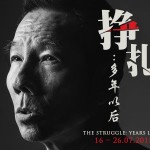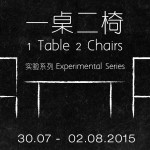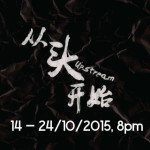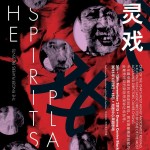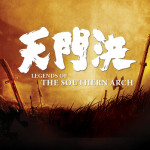“A tribute to reminisce Kuo Pao Kun”
Reviewer: Sam Kee
Performance: 17 July 2015
When the final rehearsal ended, Kuo Jing Hong walked off the stage to her sister, Kuo Jian Hong.
They hugged and cried.
Tonight, I am watching the play for the fourth time, having attended three of their rehearsals in the last two weeks*. I expect the cast will be slick and well-rehearsed and there will probably be nothing new for me to discover.
The black box is stripped bare by director Liu Xiaoyi to reveal the works of the theatre space. The atmosphere is sombre as the audience streams in. The actors are chatting lively at one corner of the stage. But the audience is unusually quiet today, eavesdropping intently.
The play unfolds as per the rehearsals. But I can feel the intensity from the participation of the audience sharing the intimate theatre space with the performers. We come to the scene where Jing Hong poses a question to Yang Ser Bin: Uncle, how did you guys get by during those trying times? There is a long pause in the middle of the sentence. She seems to be holding back a sob. I sit up, anxious for her next line to come. The audience must have sensed something wrong; all eyes are on her now. She manages to deliver her line, albeit a little late. Borrowing the words of Peter Brook, I believe the audience has ‘assisted’ the actor in some ways, causing her to offer something more than a repetition of the rehearsals.
If you are looking for an honest play based on the banned script, then you will not find it here. The director has no intention of putting up a play relating the struggle during the 1960s; he is more interested in finding out: so, what now? Years Later, after the incident of a play that was banned, what is left of that generation? What is the next generation doing? In the play, Yang says with a heavy heart that every generation has its own obligation. One cannot expect this generation to go through what the previous generation did, hence one also cannot expect this generation to make the same decisions or hold the same beliefs as the former did. The play that I just watched is a product of history – a result stemming from the play that never got staged.
Liu’s direction highlights the essence of humanity from Kuo Pao Kun’s script and brings that essence to a new audience. A strong spotlight shines onto the table where an adaptation of the original script happens. A margin of light falls off the edges of the table onto the floor. This highlights a border around it, beautifully framing this performance space. The light is so bright that it bounces off the surface of the table, and lights up the faces of the cast making them glow in an almost unreal fashion.
A microphone is attached to the table, picking up sounds when the actors interact with it. This sound design is courtesy of artist Darren Ng. Whilst Xiaoyi chooses to work with the symbolism of ‘paper’, inspired by the original playscript, Darren exploits the tactile motion on the table surface. Friction is cleverly translated into sounds that leads to a dramatic imagination of the industrial setting of the play. This setup allows Xiaoyi to present minimalistic account of the past struggle amongst the working class and relate the underlying humanistic themes to present day struggles.
*Citizen Reviewer Sam Kee was part of the reviewers-collaboration programme between Centre 42 and The Theatre Practice for the M1 Chinese Theatre Festival 2015. Sam shares her observations of the creation/rehearsal process in this written reflection (6 July 2015):
Kuo Pao Kun (KPK)’s The Struggle was banned in 1969. 46 years on, we see how director Liu Xiaoyi attempts to give the play a new slant, now aptly named: The Struggle: Years Later.The adaptation is almost synonymous to its director. Bearing in mind that Xiaoyi heads the experimental branch of The Theatre Practice, one does not expect him to follow the original struggle to the T. The adapted play is heavily laced with his trademark forms and symbols. The stage is bisected, much like his use of space in last year’s Fluid. Expect an unconventional orientation of the theatre space in Lasalle’s Creative Cube and some sort of inclined slope on the set. Xiaoyi mentions that he is more interested in the inter-play between the forms used in the storytelling of each scene, rather than playing out KPK’s script in a realism manner. The play opens with a mechanical and clinical 1-table-2-chairs setting and evolves into a wild-goose chase eventually. The structure of each successive scene becomes more and more complicated to parallel the story that unfolds to reveal the complexities in the struggle of the working class.
I see Xiaoyi as a meticulous director on the set. Given the experimental nature of his devised works – they often lack a linear narrative structure – he is ever more fastidious about the momentum of a play. He often stops to challenge the actors to make them reflect upon their motives. His inquiry approach to elicit the purpose of each performer’s entrance and existence on stage coaxes them into the right frame of mind. That seems strangely encouraging to the cast. In order to calibrate the momentum of the play, the cast would tirelessly rehearse snippets of a scene to refine their subtle interactions with each other, especially non-verbal cues. It seems that the script will remain fluid; the acts will be improvised and improved on until the actual performance.
Also, I feel that Xiaoyi tends to project a lot of significance onto the actors’ interactions with symbolic objects to derive meaning from the original work. Like his previous plays, The Struggle: Years Later is a collective creation – a product born out of a series of workshops involving everyone in the play. The team also collaborates with sound artist Darren Ng to explore the dimension of sound in theatre.
The rehearsals thus far have yet to reveal any visual projections or sets. I look forward to seeing the marriage of audio and visual projections with Xiaoyi’s minimalist storytelling form to look at The Struggle from a removed, yet reminiscent point of view.
Do you have an opinion or comment about this post? Email us at info@centre42.sg.
ABOUT THE PRODUCTION
THE STRUGGLE: YEARS LATER by The Theatre Practice
16- 26 July 2015
Creative Cube @ LASALLE College of the Arts
ABOUT THE REVIEWER
Sam Kee is currently helming the literary and visual arts section at artsrepublic.sg while putting her major in Mathematics to good use at an educational publishing house.

